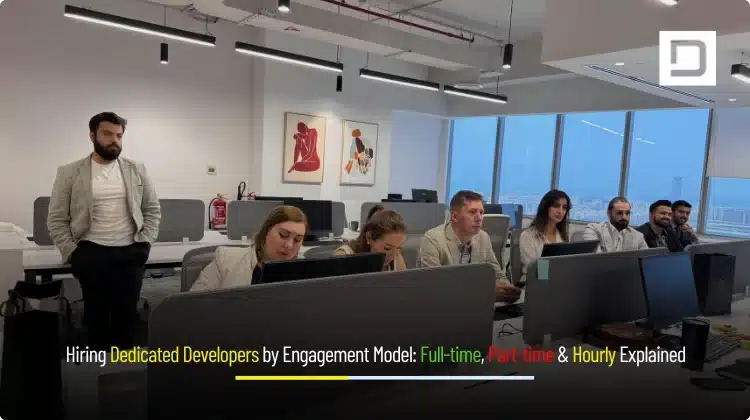Hiring Dedicated Developers by Engagement Model: Full-time, Part-time & Hourly Explained
If you are actively researching Hiring Dedicated Developers, chances are you’re weighing different engagement models and trying to decide which one will deliver the best quality, velocity, and cost control. In this comprehensive guide from Depex Technologies, we break down full-time, part-time, and hourly models in plain language, show how to align each model to your business stage, and share practical steps to Hire offshore Developers with confidence even if you began your search with phrases like offshore Developers near me. By the end, you’ll know exactly which model to pick, how to structure the collaboration, and what success metrics to track so your project stays on time and on budget.
Why Engagement Models Matter More Than Tech Stacks
A modern software project can fail even with a perfect tech stack if the engagement model is wrong. Choosing the right mix of availability, responsibility, and autonomy determines how much throughput you unlock, how predictably you ship, and how cleanly your costs map to outcomes. Full-time, part-time, and hourly arrangements each carry different trade-offs across speed, specialization, risk, governance, and total cost of ownership. Understanding those differences—before you sign a contract saves months of churn and thousands of dollars.
At Depex Technologies, we help founders, CTOs, and product leaders match the model to the mission. A fintech MVP needs rapid iteration with strong security guardrails; a mature retail platform may need ongoing feature maintenance plus seasonal spikes; an AI feature rollout may need specialized ML and data engineering on a time-boxed sprint. The right engagement model makes all of that easier.
The Three Core Models at a Glance
Although every team and project is unique, most successful collaborations fit into one of three archetypes:
- Full-time dedicated developers embedded as an extension of your in-house team. They work exclusively on your roadmap, follow your rituals, and grow institutional knowledge across sprints.
- Part-time dedicated developers who handle well-scoped, recurring responsibilities-often integration work, analytics, QA automation, devops pipelines, or specific module ownership-without the fixed cost of full-time capacity.
- Hourly dedicated experts engaged for short bursts: audits, spikes, performance tuning, incident response, proof-of-concepts, or highly specialized tasks that don’t justify a longer commitment.
Each model can be configured for onshore, nearshore, or offshore delivery. If you’re searching offshore Developers near me, you’re likely looking for time zone-compatible teams that still deliver offshore value; we’ll cover how to achieve that in practice.
When Full-Time Is the Right Choice
Full-time dedicated developers are ideal when you need sustained velocity, long-term code ownership, and predictable collaboration rituals. Choose this model if:
- You have a multi-quarter roadmap with a mix of discovery and delivery.
- You need embedded engineers who understand your domain, data models, and architecture decisions.
- You want to scale agile ceremonies standups, grooming, retros – without context switching.
- Your product requires ongoing security, compliance, or performance stewardship.
Full-time engagement shines in greenfield builds, major platform rewrites, large migrations (for example, monolith to microservices), and complex mobile-plus-backend programs. Because developers are fully dedicated, you avoid the cognitive overhead of bringing new people up to speed every sprint. The result is faster throughput, fewer defects, and a codebase that stays coherent.
Cost and ROI for Full-Time
On paper, full-time may look costlier than part-time or hourly, but the ROI is usually superior for long-horizon work. You minimize handoff delays, reduce rework, and retain architectural memory. In real budgets, those line items dwarf the per-hour difference. With Depex Technologies, full-time squads are staffed to your constraints, and we plan clear velocity targets tied to outcomes like feature throughput, defect escape rate, and lead time for changes.
Risks and How We Mitigate Them
The biggest risk with full-time is over-staffing or mis-matched skills. We solve this through skill assessments, architecture alignment workshops, and rolling 30/60/90-day checkpoints. If roadmap priorities change, we can flex capacity or rebalance skills without derailing momentum.
When Part-Time Is the Sweet Spot
Part-time dedicated developers are best when you need continuous progress on well-defined areas, but your workload doesn’t justify full-time. This model is useful for:
- Ongoing module ownership (for example, payments, reporting, or search).
- Analytics pipelines, data labeling, model monitoring, or smaller microservices.
- Quality engineering: regression suites, CI/CD hardening, performance test harnesses.
- UX iteration: component refactors, accessibility fixes, design-system maintenance.
Part-time capacity offers a stable cadence with lower fixed costs. The key to success is crisp scoping and a stable backlog. At Depex, we provide a part-time lead who manages backlog hygiene and synchronizes with your product owner so every hour ships value.
What About Collaboration Overhead?
Part-time is not synonymous with “disengaged.” We plan calendared touchpoints, link tasks to acceptance criteria, and use async updates to avoid lag. The result: steady progress, no lost context, and a budget that maps to the exact surface area you need.
When Hourly Developers Make the Most Sense
Hourly dedicated experts are perfect for precision work:
- Security hardening, cloud cost optimization, or code audits.
- Database indexing, query optimization, and performance triage.
- Emergency incidents, reliability hotfixes, and on-call reinforcement.
- Experiments or spikes to validate feasibility before larger investment.
- Specialist advisory: architecture reviews, data governance, ML workflow tuning.
The advantage is surgical precision. You get senior attention exactly when you need it, with minimal ramp-up. The trade-off is that hourly lacks the continuity of full-time or part-time. That’s why Depex pairs hourly engagements with structured findings and handover notes so changes stick.
A Practical Decision Framework
Use the following questions to translate business needs into the right model:
- What is the time horizon? If your roadmap spans multiple quarters and depends on accumulated domain knowledge, full-time is the default.
- How volatile are your priorities? If priorities change weekly, consider a part-time backbone plus hourly specialists to absorb spikes.
- What is the risk tolerance? Mission-critical systems and regulated domains benefit from a full-time squad with clear SLOs and quality gates.
- How specialized are the tasks? Highly specialized tasks-like GPU inference optimization or PCI DSS hardening—often start hourly, then become part-time sustainment.
- Where does every dollar count today? Early-stage startups often start part-time to keep burn low while testing market fit, then graduate to full-time once traction is validated.
This framework makes Hiring Dedicated Developers a strategic decision rather than a guess. If you plan to Hire offshore Developers, also factor timezone overlap, language clarity, and compliance requirements.
Offshore, Nearshore, Onshore: What Actually Matters
You’ll see wide cost deltas across regions. But the real value of offshore isn’t just rate arbitrage-it’s access to talent depth, coverage across time zones, and the ability to scale up or down without breaking your delivery rhythm. If you started with “offshore Developers near me,” you likely want both proximity and efficiency. Here’s how we achieve it:
- Timezone planning. We guarantee overlap for key rituals (planning, demos, decision reviews) and rely on async docs for everything else.
- Communication clarity. We write acceptance criteria in executable language, use living architecture docs, and record short loom-style walk-throughs for complex changes.
- Quality and security. We enforce branch protections, code reviews, SAST/DAST, secrets scanning, and least-privilege IAM across environments.
With these practices, offshore teams feel close, decisions remain traceable, and the work speaks for itself.

Detailed Comparison: Full-time vs Part-time vs Hourly
Speed to Value
- Full-time: Fastest once the team is embedded. Ramps steadily and compounds.
- Part-time: Predictable, moderate pace; ideal for incremental progress and maintenance.
- Hourly: Immediate impact for narrow problems; limited for broad initiatives.
Cost Predictability
- Full-time: High predictability with monthly burn; best for stable backlogs.
- Part-time: Flexible while still predictable; easy to dial capacity up or down.
- Hourly: Most flexible; pay only for work done, but forecasting is trickier for evolving scopes.
Knowledge Retention
- Full-time: Strongest. Institutional memory grows sprint over sprint.
- Part-time: Good if scope remains consistent and documentation is disciplined.
- Hourly: Requires structured handoff to retain value.
Risk Profile
- Full-time: Lowest execution risk for complex programs; higher commitment.
- Part-time: Balanced risk; great for stable modules and ops foundations.
- Hourly: Best for short-term or exploratory needs; manage scope tightly.
Building a High-Performance Dedicated Team
Whether you pick full-time, part-time, or hourly, success depends on how you structure the work. Here’s the Depex blueprint we apply across models:
1) Short, Specific Discovery
We start with a compact discovery: vision alignment, non-functional requirements (performance, security, compliance), architectural constraints, and a first-sprint plan. Even for hourly audits, a mini-discovery clarifies the objective so every hour moves the needle.
2) A Backlog That Engineers Can Execute
User stories carry acceptance criteria, test ideas, and context links. Tech debt items are tagged and visible. By the time a developer opens a ticket, they know why it matters, what success looks like, and what not to do.
3) Golden Paths and Guardrails
We define a happy-path for repo structure, CI/CD, environments, and feature flags. Guardrails include code review standards, automated tests, type coverage targets, and security checks. This reduces variability and makes multi-model collaboration coherent.
4) Communication Rituals That Scale
Weekly planning and demos, daily async updates, and a single source of truth for decisions. For offshore or distributed setups, we document decisions in lightweight ADRs so future contributors understand the why.
5) Metrics That Map to Business Value
We track deployment frequency, change lead time, mean time to restore, escaped defects, and unit/integration coverage. On the product side, we measure activation, retention, conversion, task success, and performance budgets. You get a narrative plus numbers—not vanity metrics.
Budgeting and Forecasting by Model
A common question in Hiring Dedicated Developers is “What will this actually cost each month?” While exact figures depend on stack and seniority, here’s how to think about it.
- Full-time: Anchor on squads rather than individuals. A balanced pod (backend, frontend, QA, DevOps) with a tech lead delivers more than a collection of isolated contractors. Budget monthly; forecast velocity using historical throughput and a rolling three-sprint average.
- Part-time: Budget in blocks aligned to modules. For example, reserve a fixed weekly block for data pipelines and a separate block for design-system quality. This keeps spend consistent and outcomes visible.
- Hourly: Budget per objective. For a performance audit, reserve a capped number of hours with clear deliverables: findings, prioritized fixes, and measurable wins (for example, p95 latency reduced by X%).
Depex provides transparent estimates and conversion paths between models. If an hourly engagement reveals deeper needs, we can graduate to part-time or full-time without losing context.
Security, IP, and Compliance
Hiring Dedicated Developers should never compromise security. We implement least-privilege access, environment isolation, secret management, and secure coding practices across all engagement models. NDAs and IP assignment are standard. For regulated industries, we align with your policies (for example, SOC 2 controls, GDPR data handling, HIPAA considerations) and validate that toolchains meet compliance thresholds. Offshore does not mean off-policy; it means your policies are enforced consistently across borders.
How to Evaluate a Partner Before You Commit
If you’re about to Hire offshore Developers or even local specialists, evaluate on more than CVs:
- Process maturity: Can the partner show how they handle planning, delivery, and incidents?
- Architecture clarity: Can they explain trade-offs, show ADRs, and run a design review?
- Testing culture: Do they ship with automated coverage and performance baselines?
- Communication style: Are updates clear, on schedule, and linked to measurable outcomes?
- References and case narratives: Not just logos-what problems did they solve, and what changed?
At Depex, we offer a structured technical interview, a sample backlog review, and a short pilot to validate ways of working before scaling up.
Playbooks by Company Stage
Early-Stage Startup
You need speed and learning. Start with part-time plus hourly spikes: one part-time full-stack developer to own the backbone, and hourly specialists for critical spikes like payments, auth, or analytics. As traction arrives, promote to a full-time pod to increase velocity without re-onboarding.
Scale-Up
Stability matters as much as speed. Adopt a full-time core squad that owns architecture and major features. Add part-time streams for QA automation and data. Use hourly for security audits and performance tuning ahead of big launches.
Enterprise
Governance, compliance, and predictability drive decisions. Full-time is the primary model with well-defined SLAs. Part-time teams manage specific platforms or business units. Hourly experts step in for niche needs-mainframe integrations, data lineage audits, or zero-downtime migrations.
Real-World Scenarios
Scenario 1: The Checkout Rebuild
A D2C brand suffers abandoned carts and slow pages. We deploy a full-time squad to refactor the checkout, optimize queries, and introduce feature flags for safe rollout. Part-time QA hardens test coverage. Hourly performance experts profile the hottest paths. Result: conversion lifts, faster p95, and fewer support tickets.
Scenario 2: Analytics You Can Trust
A SaaS company wants reliable metrics without retiring the product roadmap. Part-time data engineers build a clean pipeline and dbt models while frontend stays focused. An hourly advisor reviews privacy posture. The company gets trustworthy dashboards without a hiring freeze.
Scenario 3: Cloud Cost Surprise
A startup sees cloud bills spike after a viral feature. Hourly cloud specialists triage hotspots and right-size resources. A part-time DevOps stream then keeps costs optimized. The team avoids over-committing to full-time DevOps before the need is proven.
Making Offshore Feel Next-Door
Success with offshore engagement comes down to alignment, not mileage. Here is how Depex makes distributed work feel local:
- Overlap windows: We carve overlapping hours with your local team for decisions and demos.
- Async mastery: Short, targeted updates with links to code, screenshots, and metrics.
- Shared definition of done: Quality gates and acceptance criteria, visible to everyone.
- Single source of truth: Centralized backlog and docs so nothing gets lost in chat history.
- Cultural empathy: Direct, respectful communication and proactive clarification remove friction.
If your search began with offshore Developers near me, our blended model gives you the timezone comfort you want and the global talent density you need.
Common Mistakes to Avoid
- Treating hourly as indefinite: Hourly should be objective-based. Define success, capture learnings, then level up or stop.
- Under-scoping part-time: If you under-feed the backlog, velocity drops and context decays. Keep a healthy pipeline of ready work.
- Over-hiring full-time too soon: A large squad without validated priorities burns budget. Grow with proof points.
- Ignoring documentation: Regardless of model, capture decisions and interfaces. Documentation is how small teams act big.
How Depex Technologies Orchestrates the Right Model
When clients ask about Hiring Dedicated Developers, our approach is straightforward:
- Discovery and alignment: Clarify success criteria, constraints, and first wins.
- Capability mapping: Match skills and seniority to your architecture and roadmap.
- Engagement design: Choose full-time, part-time, hourly-or a hybrid-with clear roles, schedules, and rituals.
- Governance: Define metrics, reviews, and quality gates so progress is measurable.
- Adaptation: Inspect and adapt. As your needs evolve, we adjust capacity and skills without disrupting cadence.
This is how we help you Hire offshore Developers with confidence while keeping control over outcomes.
FAQ: Quick Answers for Busy Leaders
Is a hybrid model viable?
Yes. Many clients run a full-time core squad, a part-time reliability stream, and a small hourly pool for rapid experiments.
How do we ensure quality across time zones?
Guardrails. Code reviews, automated tests, security checks, and deployment gates mean quality doesn’t depend on the clock.
What if we need to pause?
Part-time and hourly models flex easily. For full-time, we plan soft landings and keep documentation current so resumption is painless.
Can you work inside our stack and tools?
Absolutely. We adopt your repos, CI/CD, ticketing, and observability platform to minimize change management.
What about IP and security?
NDAs, IP assignment, and least-privilege access are standard. We align to your policies from day one.
Your Next Step
If you’re comparing full-time, part-time, and hourly, remember: the best model is the one that maps cleanly to your stage, your risk tolerance, and the outcomes you owe your users. Whether you need a squad to own the roadmap, a steady hand on critical modules, or precision fixes from senior experts, Depex Technologies will help you choose and execute the right path. Hiring Dedicated Developers shouldn’t be a gamble; it should be a lever that compounds product velocity and business value.

Conclusion: Build with Confidence-Build with Depex
You’re not just purchasing hours; you’re buying outcomes. With Depex Technologies, you get a partner that designs the engagement model around your reality.For sustained momentum, choose a full-time pod that behaves like your own team. When you want targeted progress without fixed overhead, a part-time stream is ideal. And for specialized help, bring in hourly experts who tackle the hard bits and leave you stronger. Wherever you are in the journey-from MVP to enterprise scale-our process, communication style, and quality guardrails ensure you ship faster, safer, and smarter.
Ready to turn your roadmap into shipped software? Contact Depex Technologies to Hire offshore Developers and build with a team that feels like your own-reliable, transparent, and tuned to deliver.






